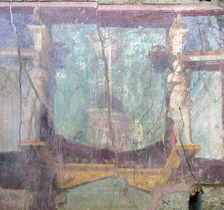 1>
1>Beyond the Wall – the paradigm shift
Using the real wall and its simulacrum as a potent psychological agent, was not only confined to the First Style and its depictions of marble walls and eternity motifs. In one form or another this duality existed throughout Roman wall-painting.
The numerous depictions of walls in Roman wall-painting located themselves within the psychological indivisibility that occurs when objects are replaced, in the same location, by their pictorial counterparts. Unlike Parrhasius’s pictorial curtains that fooled the artist Zeuxis into asking for them to be opened, Roman wall-painting went beyond mere trompe l’oeil trickery. It did not substitute the simulacrum for the object itself in order to bring about closure, but to expose the viewer to the possibility of metaphysical spaces beyond the pictorial curtain or wall, and thus by implication its physical counterpart (fig.1).
If the current chronology is correct a major paradigm shift took place in Roman wall-painting in the early years of the first century BC. The faux marble grandeur that had satisfied inhabitants for a few hundred years, began to incorporate spatial features that suggested the existence of a world beyond the interior walls of the house or villa (fig.2).
What caused this to occur is a matter of conjecture, as is the place in which it first occurred. If it began in the Campanian region then there is a strong possibility that the shift took place in response to the civil wars that either prefigured or accompanied the paradigm shift. This region was particularly caught up in the conflict that finally led to Rome's annexation of cities such as Pompeii. The trauma preceding this event may well have triggered the desire to escape into the type of transcendental worlds that the wall-paintings increasingly portray. If the shift took place after annexation then it is more likely to have been the result of broader socio-cultural influences emanating from Rome.
Whilst the when and the where of the paradigm shift requires more research, its visual manifestation can be traced through the wall-paintings. The material evidence initially shows an increasing desire to make the faux marble walls appear even grander by including architectural features such as architraves, pilasters and columns. Increasingly ornate marble patterns appeared in the rectangular sections created by the architectural depictions. From a psychological point of view, the wall became a more refined simulacrum of itself, whilst at the same time remaining planar and enclosing. A much-quoted early example was found on the Palatine Hill in Rome under the foundations of the Domus Flavia. Casa dei Grifi displays many First Style planar features but, in addition, frames them using pilasters and architraves (fig.3).
|